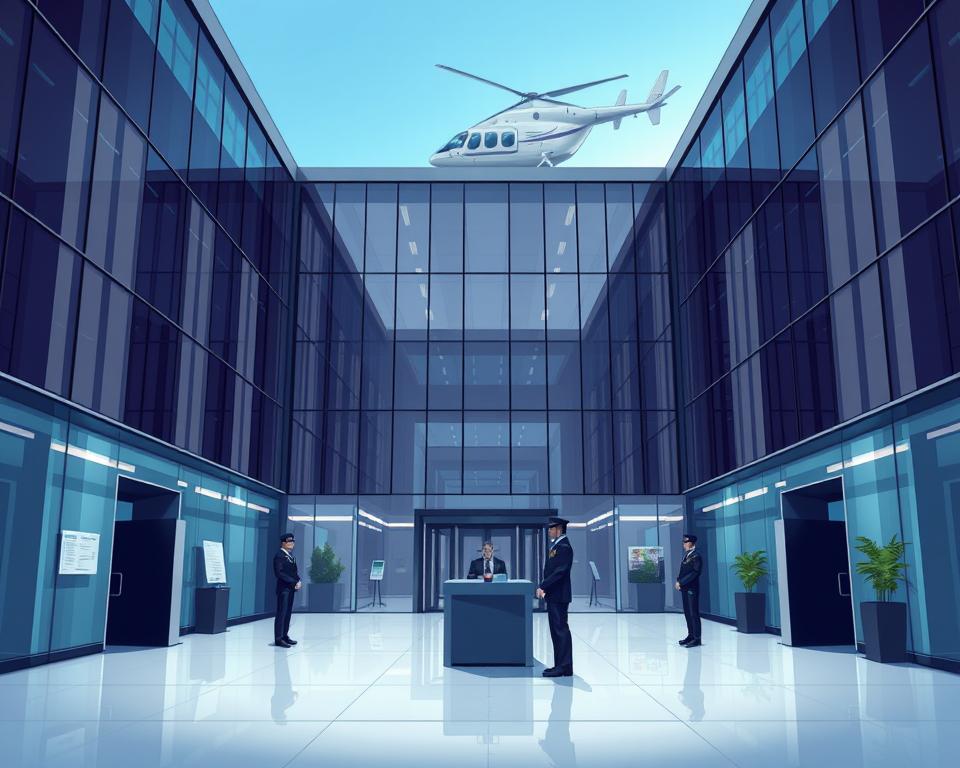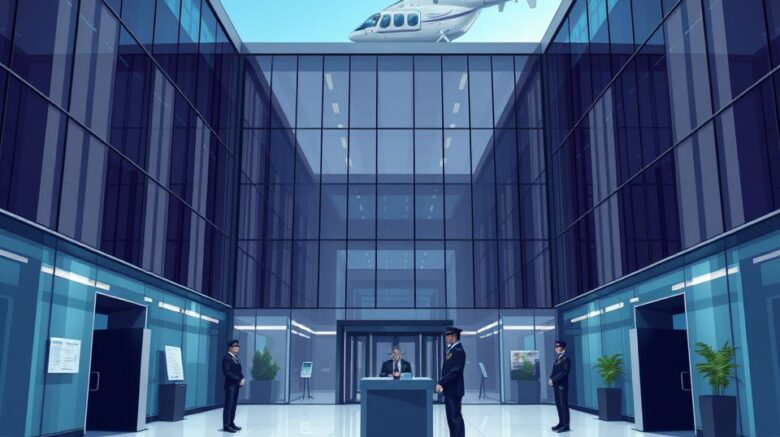Advancing Your Safety through Mall Security Measures
What if safer shopping requires more than cameras and guards? As shoppers increase and threats transform, creating secure spaces requires more than traditional methods. Today’s threats require intelligent strategies combining human skill and advanced tech.
In light of increasing public safety worries, organizations now focus on solid defense systems. Divine Protection Services champions this movement, merging strict training with advanced tools to define industry benchmarks. Their strategy prioritizes proactive commercial security guards steps over reactive reactions.
Well-prepared officers play a vital role in maintaining order. They observe bustling areas, manage crisis situations, and create trust through their visible presence. This people-first philosophy guarantees that shoppers and employees feel secure at all times.
The following sections will examine how surveillance advancements and access controls form coherent security networks. Find out how strategic planning reshapes malls into safe zones while aiding business growth.
Grasping the Need for Mall Security
Building secure zones for shoppers and employees requires more than obvious patrols. Contemporary protection strategies depend on multi-layered approaches integrating technology, training, and teamwork. These systems not only respond to incidents—they preempt them.

Surveillance and Access Control: Their Role
High-res cameras and intelligent access systems form the foundation of current safety plans. Sensors placed strategically monitor busy areas like entrances and parking lots. This structure enables teams to identify irregular activity promptly.
Access control tools block entry to restricted sections while letting patrons move freely through shops. Regular equipment checks ensure cameras and scanners work flawlessly. Real-time monitoring helps teams respond before minor issues escalate.
Safety, Reputation, and Customer Experience
Skilled officers do more than view screens—they aid lost visitors and defuse conflicts. Their presence reassures patrons, encouraging longer stays and repeat visits. A single event can erode trust, making prevention essential.
Backing continuous staff training guarantees teams tackle medical emergencies or crowd surges competently. When security protocols sync with daily functions, businesses succeed amid safer settings.
Divine Protection Services: Your Ally in Mall Safety
When security is paramount, companies need partners who provide more than assurances. Divine Protection Services stands out by blending advanced tools with skilled personnel to address modern risks. Their methods adjust to changing threats while preserving a friendly environment for guests.
Our All-Encompassing Security Strategy
This firm merges three pillars for peak effectiveness:
- Sophisticated surveillance networks tracking high-traffic areas
- Access control systems that regulate entry without impeding foot traffic
- Frequent equipment upgrades ensuring consistent performance
Their crew uses live data to recognize odd patterns, from unattended bags to unpermitted entries. This preemptive method stops problems before they worsen, preserving public areas secure yet accessible.
Enabling Security Officers with Training and Support
Divine Protection Services invests heavily in skill development. Officers obtain:
- BST certification for managing aggressive situations
- First aid education for medical emergencies
- Customer service classes enhancing guest interactions
Ongoing development opportunities guarantee teams are equipped for different scenarios. “Our team members aren’t just guards—they’re safety ambassadors,” mentions a company spokeswoman. This attention to growth instills confidence in both personnel and customers, establishing environments where everyone flourishes.
Training, Certifications, and Employee Excellence in Security
Supporting security guards starts with more than just a uniform—it demands comprehensive preparation. Staff succeed when endowed with certifications and experiential training geared to modern challenges. This base converts routine interactions into prospects to cultivate trust and avoid incidents.
Core Training Programs and Certifications
Security staff initiate with three principal certifications: BST for conflict resolution, first aid for medical crises, and non-violent intervention strategies. These abilities aid in defusing tense scenarios while putting visitor safety first. Periodic seminars renew these capabilities, making sure teams adjust to emerging threats.
Simulation exercises replicate real-world scenarios like crowd surges or lost children. Self-paced courses cover new developments, from electronic surveillance tools to accessibility procedures. “Training never ends—it adapts,” explains a Divine Protection Services instructor. This strategy keeps teams equipped for both everyday duties and unforeseen alarms.
Building a People-First Culture in Security
Ongoing education nurtures empathy and problem-solving skills essential for public areas. Security staff trained in customer service support shoppers with directions or store advice, merging safety with hospitality. This dual emphasis shapes welcoming atmospheres where people feel appreciated.
Divine Protection Services reinforces this culture through mentorship programs and equipment mastery sessions. Confident, well-equipped teams diminish risks while enhancing community bonds. The payoff? Safer retail spaces where employees and visitors alike can focus on core activities.
Mall Security: Tips for a Protected Shopping Environment
How do busy shopping centers balance safety with seamless visitor experiences? The answer lies in combining watchful technology with approachable personnel. Today’s tactics emphasize preventing problems while upholding inviting environments.
Optimizing Visibility Through Technology
High-resolution cameras now cover key zones like parking garages and food courts. These systems use motion detection to flag unusual activity, such as lingering packages or erratic movements. Centralized dashboards let teams track multiple areas simultaneously.
Periodic upkeep tests confirm sensors and alarms work without issues. “Our weekly system inspections block 90% of potential malfunctions,” mentions a retail safety manager. Integrating live video with AI analysis helps identify patterns human eyes might miss.
Integrating Safety With Hospitality
Skilled officers frequently serve as information guides. They guide shoppers with store directions, lost items, and parking queries. This twofold role fosters trust while maintaining security.
Entry management tools like smart turnstiles limit access to staff areas without slowing foot traffic. Color-coded IDs enable instant identification of authorized personnel. During rush hours, temporary checkpoints regulate crowd flow near top stores.
Monthly collaboration meetings between teams ensure everyone understands emergency protocols. Small changes—like improved lighting near restrooms—can ward off incidents while enhancing visitor comfort. When technology and team effort combine, public spaces become both safer and more pleasant.
Managing Emergencies and Crowds in Shopping Malls
When seconds are vital, how do crowded areas convert chaos into order? Effective emergency approaches merge clear protocols with trained teamwork. Preparation changes potential crises into manageable events where everyone knows their role.
Effective Emergency Management Techniques
Preplanned action plans are crucial in emergencies. Teams use color-coded alerts to signal different threat levels—red for fires, yellow for medical issues. This approach lets staff act promptly without confusion.
Primary strategies encompass:
- Assigned evacuation pathways marked with glow-in-the-dark signs
- Real-time communication via encrypted earpieces
- Automated lockdown capabilities for secured areas
Security staff educated in crowd psychology direct patrons with calm verbal prompts and visual signals. “We hold疏散 drills monthly to preserve instinctive reactions,” shares a retail safety coordinator. Surveillance feeds help identify bottlenecks, allowing teams to redirect foot traffic before panic spreads.
Local fire services get real-time updates via integrated systems during incidents. Collaborative training drills guarantee smooth collaboration. Post-action evaluations highlight areas for improvement, like swifter first aid deployment.
One Midwest complex reduced evacuation times by 40% after upgrading their speaker network. Ongoing updates to response protocols ensure teams tackle new challenges while sustaining visitor confidence.
Tech Developments and Emerging Trends in Mall Security
Envision stepping into a venue where safety systems detect risks before they manifest. Cutting-edge innovations are reshaping how public areas protect visitors while enhancing convenience. From AI-driven analytics to biometric scanners, tomorrow’s solutions blend precision with seamless operations.
Intelligent Systems for Proactive Protection
Machine learning today reviews camera feeds to identify odd behavior, such as unattended bags or erratic movements. These tools alert on potential hazards faster than manual monitoring. Predictive systems analyze historical data to estimate peak traffic intervals, aiding teams in allocating resources effectively.
Advanced access systems use facial recognition to grant entry to restricted zones. “Biometric tech reduces unauthorized access by 78%,” notes a retail safety expert. Live dashboards show crowd density stats, letting officers reroute foot traffic before bottlenecks arise.
Training modules now integrate virtual reality simulations. Guards rehearse dealing with situations from medical emergencies to active threats. This experiential method develops muscle memory for high-stress situations.
Future trends point to drone patrols for parking lots and IoT-connected sensors detecting environmental hazards. As tech evolves, shoppers enjoy smoother visits while feeling safeguarded. Companies using these tools remain ahead in crafting spaces where security and satisfaction flourish together.
In Conclusion: Enhancing Mall Safety with Confidence
Building safer shopping environments starts with confidence in both strategy and execution. Divine Protection Services spearheads this effort by merging AI tools with expertly trained personnel. Their approach shifts traditional protocols into responsive systems that adapt to emerging challenges.
Today’s safety depends on three pillars: real-time monitoring, precise access control, and prompt emergency response. Teams using predictive analytics can spot risks before they escalate, while customer-focused officers ensure smooth operations. This mix of technology and humanity builds areas where visitors feel safe yet free to wander.
Investing in continuous upgrades ensures long-term success. From biometric readers to crowd management analytics, innovation keeps venues ahead of threats. Partnering with experts like Divine Protection Services guarantees tailored solutions that grow with your needs.
Set to improve your safety standards? Explore how cutting-edge systems and compassionate service can transform your space. Peace of mind begins with proactive partnerships—take the first step toward a secure future today.
FAQ
How does access control boost safety in public venues?
Access control limits entry points, reduces unauthorized access, and helps teams monitor foot traffic. Systems like keycard readers or biometric scanners ensure only approved visitors enter restricted areas, creating a safer environment for everyone.
What certifications should security officers have?
Security personnel should obtain certifications like CPR/First Aid, crisis intervention training (CIT), and state-authorized licensing. Programs such as ASP baton training or de-escalation classes also train teams to handle high-pressure situations effectively.
How do surveillance systems adjust to large crowds?
Cutting-edge systems utilize AI-based cameras to observe movement patterns and flag anomalies. During peak hours, live feeds help teams redirect foot traffic, manage bottlenecks, and respond quickly to incidents without disrupting shoppers.
Why is customer service critical for security personnel?
Courteous interactions cultivate trust and prompt patrons to report concerns. Officers trained in communication skills can assist with directions, lost items, or minor conflicts, enhancing the overall experience while maintaining vigilance.
How does technology contribute to emergency response?
Technology like panic buttons, live communication platforms, and combined alarm systems lets teams coordinate more swiftly. For example, automated alerts can lock down sections or guide evacuations during critical situations.
How does Divine Protection Services support its teams?
They provide ongoing training, advanced equipment like body cameras, and 24/7 operational backup. Consistent drills and access to industry specialists guarantee officers stay equipped for changing challenges in public spaces.
Can AI decrease risks in retail environments?
Yes! Machine learning analyzes data to predict hotspots for theft or accidents. Cameras employing facial recognition or plate tracking also assist in spotting repeat offenders before issues grow.
What methods prevent conflicts during busy seasons?
Visible signage, designated rest areas, and staggered entry points relieve congestion. Security staff trained in crowd management apply non-confrontational tactics to ease tensions and keep crowds orderly.
